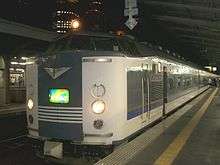583 series
| 583 series | |
|---|---|
|
583 series on Aizu Liner service, September 2008 | |
| In service | 1967–Present |
| Manufacturer | Hitachi, Kawasaki Heavy Industries, Kinki Sharyo, Nippon Sharyo, Tokyu Car Corporation |
| Constructed | 1967-1972 |
| Entered service | 1967-present |
| Number built | 434 vehicles |
| Number in service | 6 vehicles |
| Number preserved | 4 vehicles |
| Number scrapped | 424 vehicles |
| Formation | 6, 10, 12, 13 cars per set |
| Operator(s) |
JNR (1967-1987) JR Hokkaido (1987-1990) JR East (1987-present) JR-West (1987-2013) |
| Depot(s) | Akita, Sendai, Kyoto |
| Specifications | |
| Doors | 1 per side (except dining car) |
| Maximum speed | 120 km/h (75 mph) |
| Traction system | Resistor control |
| Acceleration | 1.3 km/h/s |
| Electric system(s) | 1,500 V DC, 20 kV AC 50 Hz (583 series), 60 Hz (581, 583 series) |
| Braking system(s) | Dynamic brake, Electro-pneumatic brake |
| Safety system(s) | ATS-S, ATS-P |
| Track gauge | 1,067 mm (3 ft 6 in) |


The 581 / 583 series (581 / 583系 Gohyaku-hachijūichi / gohyaku-hachijūichi-kei) are limited express electric multiple unit (EMU) train types introduced in 1967 by Japanese National Railways and operated by East Japan Railway Company (JR East) and West Japan Railway Company (JR-West) on the through services express Kitaguni and other special trains.
The seats of the 581 and 583 series can be transformed into three-berth beds, enabling the trains to be used on both daytime and night train services.
The 581 series was introduced in 1967 on the Midori (Shin-Ōsaka - Kumamoto daytime limited express) and Gekkō (Shin-Osaka - Hakata night limited express).
The 583 series was introduced in 1968 on the Hatsukari (Ueno - Aomori via Tōhoku Main Line daytime), Hakutsuru (Ueno - Aomori via Tōhoku Main Line night), and Yūzuru (Ueno - Aomori via Jōban Line night).
These trains were subsequently used on other limited express services.
In 1982, when the Tōhoku Shinkansen opened, many cars became surplus to requirements, and some were remodeled into 419 series and 715 series EMUs.
Individual car types
- KuHaNe 581: Cab car with air compressor and motor-generator (150 kVA)
- KuHaNe 583: Cab car with air compressor and motor-generator (210 kVA)
- MoHaNe 580: Motored car with two pantographs (1,500 V DC / 20 kV AC 60 Hz)
- MoHaNe 581: Motored car coupled to MoHaNe 580
- MoHaNe 582: Motored car with two pantographs (1,500 V DC / 20 kV AC 50/60 Hz)
- MoHaNe 583: Motored car coupled to MoHaNe 582
- SaHaNe 581: Intermediate trailer car. All withdrawn.
- SaRo 581: Green (first class) intermediate trailer car. The seats cannot be converted into berths.
- SaRoNe 581: Converted from SaRo 581 in 1985 for Kitaguni services. The berths cannot be converted into seats.
- SaShi 581: Dining car. All withdrawn
Formations
(as of 1 July 2010)[1]
JR East (Akita Depot)
| Car No. | 1 | 2 | 3 | 4 | 5 | 6 |
|---|---|---|---|---|---|---|
| Numbering | KuHaNe 583 | MoHaNe 582 | MoHaNe 583 | MoHaNe 582 | MoHaNe 583 | KuHaNe 583 |
JR East (Sendai Depot)
Set N1/N2:
| Car No. | 1 | 2 | 3 | 4 | 5 | 6 |
|---|---|---|---|---|---|---|
| Numbering | KuHaNe 583 | MoHaNe 582 | MoHaNe 583 | MoHaNe 582 | MoHaNe 583 | KuHaNe 583 |
JR-West (Kyoto Depot)
Sets B04-06:
| Car No. | 1 | 2 | 3 | 4 | 5 | 6 | 7 | 8 | 9 | 10 |
|---|---|---|---|---|---|---|---|---|---|---|
| Numbering | KuHaNe 581 | MoHaNe 582 | MoHaNe 583 | MoHaNe 582 | MoHaNe 583 | SaRo 581 | SaRoNe 581 | MoHaNe 582 | MoHaNe 582 | KuHaNe 581 |
Interior
-
Seating arrangement in a 583 series coach
-
The interior of a Saro 581 Green seating car in 2010
-

The interior of a SaShi 581 dining car in 1985
Preserved examples
As of April 2016, four former 581 series cars are preserved statically.
- KuHaNe 581 8: Preserved at the Kyushu Railway History Museum in Kitakyushu, Fukuoka (cosmetically restored from its previous identity as KuHa 715-1).[2]
- SaHaNe 581 19: Preserved at the "Truck Kingdom" (トロッコ王国) in Bifuka, Hokkaido.[2]
- SaShi 581 31: Preserved adjacent to the Hachinohe City Museum in Hachinohe, Aomori.[2]
- KuHaNe 581 35: Preserved at the Kyoto Railway Museum in Kyoto since April 2016.[3]
In February 2015, JR-West car KuHaNe 581 35, formerly stored at Suita Depot in Osaka, was moved to Kyoto for exhibition at the Kyoto Railway Museum opening in April 2016. It was returned from its previous Kitaguni livery to its original JNR blue and cream livery.[4]
-

KuHaNe 581 8 at the Kyushu Railway History Museum
-
KuHaNe 581 35 at the Kyoto Railway Museum in May 2016
References
- ↑ "世界初の寝台電車 581系・583系 (581/583 Series - The World's First Sleeping Car EMU)". Tetsudō Daiya Jōhō Magazine. Japan: Kōtsū Shimbun. 39 (318): 10–31. October 2010.
- 1 2 3 Sasada, Masahiro (25 November 2014). 国鉄&JR保存車大全2015-2016 [JNR & JR Preserved Rolling Stock Complete Guide 2015-2016] (in Japanese). Tokyo, Japan: Ikaros Publications Ltd. p. 124. ISBN 978-4863209282.
- ↑ 京都鉄道博物館 [Kyoto Railway Museum]. Japan Railfan Magazine (in Japanese). Vol. 56 no. 662. Japan: Koyusha Co., Ltd. June 2016. p. 50.
- ↑ クハネ581-35が回送される [KuHaNe 581-35 moved]. Japan Railfan Magazine Online (in Japanese). Japan: Koyusha Co., Ltd. 15 February 2015. Retrieved 16 February 2015.
Further reading
- Fukuhara, Shunichi (28 February 2011). 581・583系物語 [The 581 and 583 series story]. Japan: JTB Can Books. ISBN 978-4533081569.
- Teramoto, Mitsuteru (2014). よみがえる583系 [Recalling the 583 series]. Japan: Gakken Publishing. ISBN 9784054061095.
External links
| Wikimedia Commons has media related to JNR 583. |
- "Kitaguni 583 series (JR Odekake net)". Archived from the original on 14 October 2012. Retrieved 2010-01-06. (Japanese)


